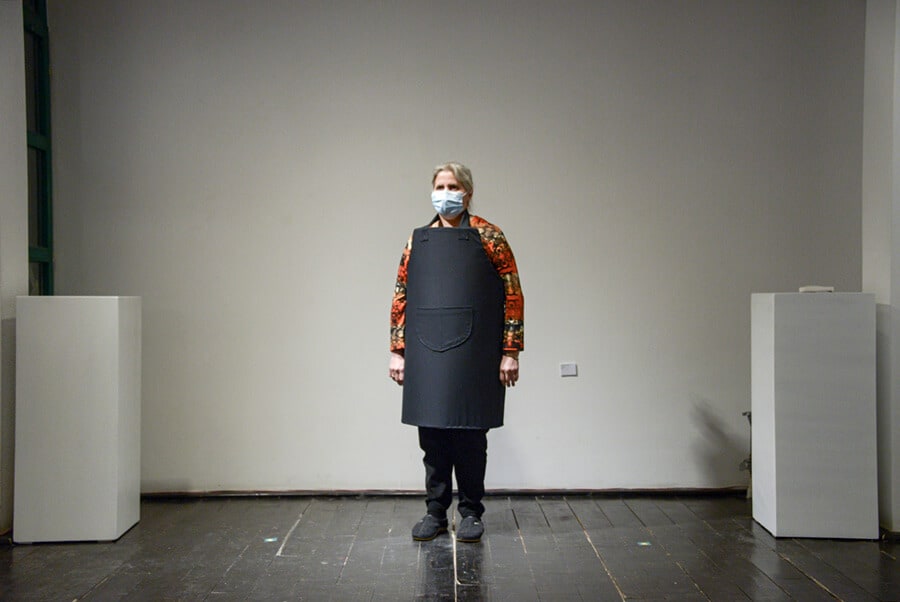We use the word home to describe a safe, treasured and lovely place. In spite of this, the four house-walls very often hide the harsh reality of one in three women and girls experiencing physical or sexual violence in their lifetime, most frequently by an intimate partner.
Home may be a private space, but the domestic violence happening in it cannot remain a private issue. It is a public concern and it should be brought into public space, to challenge and raise awareness about it.

International Day for the Elimination of Violence against Women has been observed just recently, on 25 November. Like in previous years, this date also marks the launch of 16 days of activism.
Youth Time unites with this worldwide demand by highlighting the exhibition, Kitchen Recipes (Alb: Recetë Kuzhine), which draws the public attention toward the violence against housewives happening in the kitchen.
The author of this exhibition, Arianit Beqiri, a young artist from Prishtina, Kosovo, walks us through the idea of this exhibition. Speaking from a more personal angle and combining it with an artistic expression, he calls on the importance of ending domestic violence against women.
An Apron Serving as the Armour of Housewives
The main part of the exhibition shows Beqiri’s mother posing in the kitchen while wearing body armour. The body armour resembles the apron that she uses every day.
Since I had the opportunity to visit the exhibition I have my own understanding of its key message; the kitchen is the place where women cook, and often the place of violence against them too. However, Beqiri walks us through the path and message of the exhibition from his eyes.
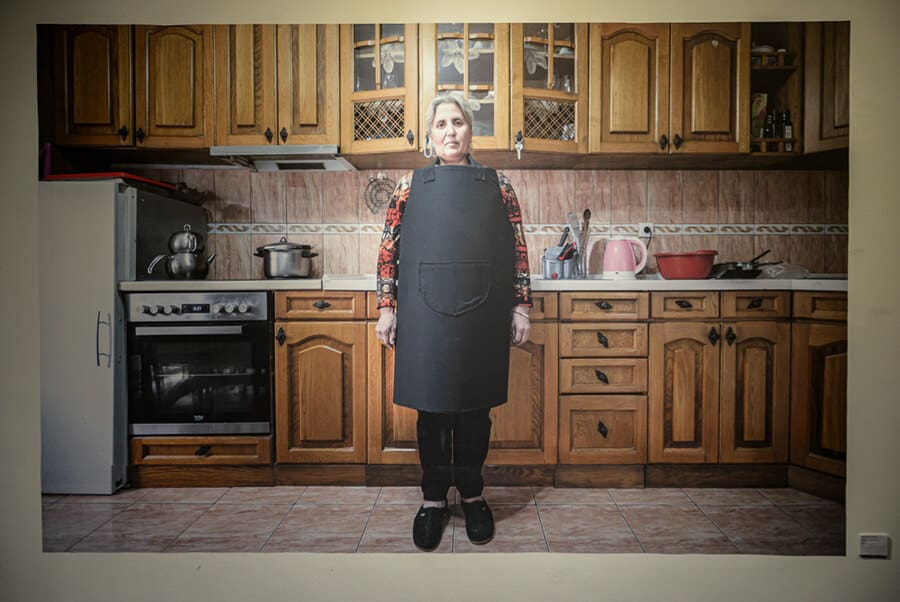
“If women are the ones who know the cooking recipes – or at least they are expected to since society has placed them in the kitchen – from what we have seen in the past is men are usually those who know the ‘violence recipe’.
“Through this exhibition I wanted to say one thing. To change the mindset that women belong in the kitchen, we have to change our way of thinking towards housework, the relations between men and women or women in general.”
Regrettably, Beqiri further adds “Until this is achieved, many more women will be killed.”
“It is terrible to know that a man thinks that he has the right to kill his wife whenever he finds it ‘necessary’.”
According to him, ‘the armour for housewives’ will be necessary until no one thinks something like this.
The Invisible Hand of a Mother
In one of his interviews, he describes that even if he left his bed unmade in the morning, still, in the evening he would find it made by his mother.
Was this the moment of the inspiration for this exhibition, and why Beqiri thinks that the home was the most powerful place to choose for illustrating the domestic violence against women?
“I have always had the impression that things in our home have a living spirit. Whenever I undressed and left the clothes all over the floor, in the evening they were not there anymore.
“As if in the meantime they had taken a life form and moved. But, one evening, when I came back home, the clothes were just where I left them. This time they had not moved.”
This is the moment that Beqiri describes as an “epistemological rift” experience – the very moment where he realised that the clothes had not indeed moved by themselves.
“In fact, behind my initial thought: ‘moved by themselves, stood the invisible hand of my mother’. This is where and when, my ideas started to take shape”.
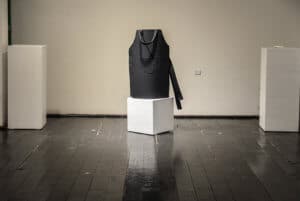
Beqiri further explains the apron, which is at the centre of the exhibition.
“The apron is body armour. There are three pieces here; one body armour, a video showing my mother making the body armour, in between of this, she still finds time to cook- symbolising that she is preparing to protect herself, and in spite of this she cannot afford to not prepare the meals for family members. At the end, she wears it and goes to the kitchen.”
A Single Red Cup Speaking Volumes
Another installation represents an apron made out of all white dishes, with a single red cup of coffee.
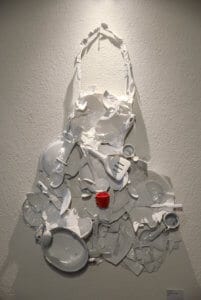
Beqiri elaborates the meaning behind each colour, while saying that violence against women is systematic and multilayered.
“We use the dishes for preparing food, however they are often used as tools for violence against women. All of these dishes, painted in white, form another apron. In this apron I have put here a red cup.
“First, it is placed around the genital area, as society defines female morality based on it, and second, it is red because of the colour of blood.”
If you look carefully, the cup’s holder is absent.
“The only taste of escape or liberty comes at the time when the woman is drinking coffee. A cup holder is missing to illustrate that this liberty ends right away – just as quick as drinking the coffee does.”
“The Creation of Adam” in Another Dimension
Part of this exhibition is also one of the most famous works of Michelangelo – The Creation of Adam, accompanied with a repetitive background voice saying do not touch.
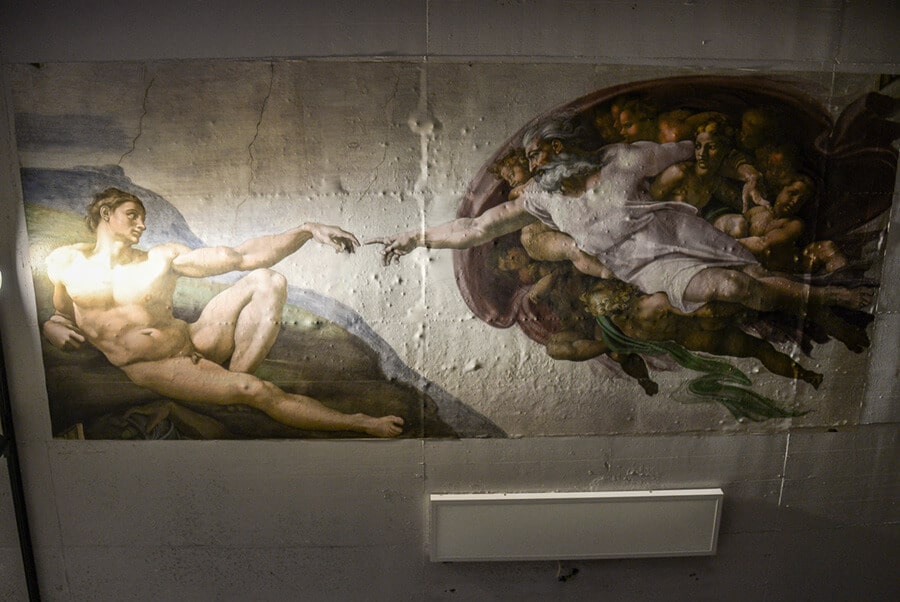
He explains to what extent the two are related.
“If Adam was not created, none of this violence would have happened. This is my desperate call. Let’s not forget that two of Adam’s sons kill each other. If Adam would have had a brother, he would kill him too maybe?”
“Yet, Adam had only Eve by his side. In this way, he showed only his animalistic side – reproduction. Seemingly, the violence happening today was thought since the beginning as Adam’s creation. If for them the apple was forbidden, why is it not for the rest of us?”
Art as a Form of Expression and Protest
Through art, Beqiri challenges the patriarchal mindset and seeks a better, equal life for women. Speaking from his experience, he shows how art can become an ally of the women’s rights movement.
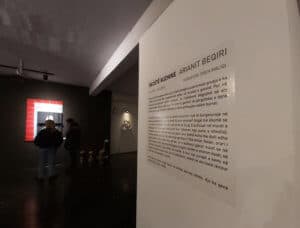
“Art has often supported the suppressed. Without artists’ contribution, important political and social changes would have not taken place. However, artists should be very careful regarding what they want to represent through their art. The talent of the artist is like a gun – one should be aware of what direction it is firing.”
He acknowledges the paradox of speaking about guns in an exhibition fighting for women victims and survivors of gun and domestic violence.
“However, this is art. It is a constant clash of ideas, beliefs, realities and impossibilities. For a defeatist conclusion, I would say that today art at times is in danger/at risk from itself.”
Photos: Patrik Domi, Armend Gashi, Youth Time
The fight for equality is happening on many levels. Here is another one about another way of domestic violence:
What is the Gender Equality Index and Why Should We Keep an Eye on it?
Support us!
All your donations will be used to pay the magazine’s journalists and to support the ongoing costs of maintaining the site.
Share this post
Interested in co-operating with us?
We are open to co-operation from writers and businesses alike. You can reach us on our email at cooperations@youthtimemag.com/magazine@youthtimemag.com and we will get back to you as quick as we can.
